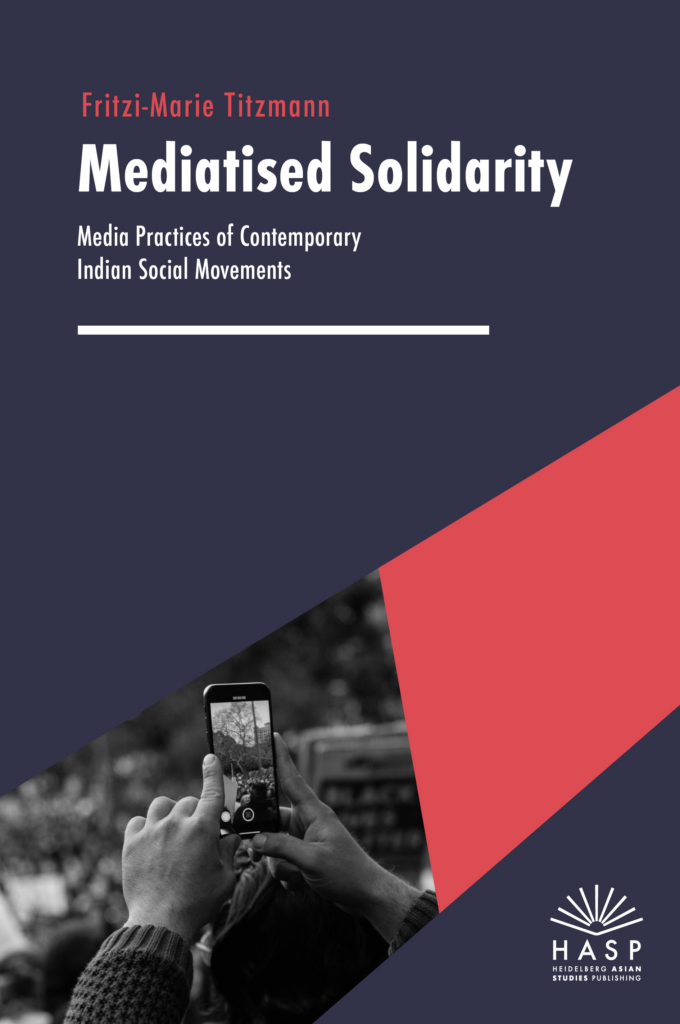
Solidarity in social movements involves a sense of shared enthusiasm, devotion, and identification with the group (Benford, 2013). Mediated spaces offer a new paradigm for expressing solidarity in social movements and socio-economic planning, creating conditions for the full exercise of citizenship (Cardoso, 2006). Fritzi-Marie Titzmann’s book, Mediatised Solidarity: Media Practices of Contemporary Indian Social Movements, published by Heidelberg Asian Studies Publishing (HASP) in 2024, explores these themes in depth.
In an era where activism is increasingly shaped by digital landscapes, Mediatised Solidarity is a timely intervention. This book delves into the intersection of media, activism, and solidarity, examining the interplay between various forms of media to build networks, mobilize supporters, and challenge dominant narratives, during the contemporary movements in India leverage.
With a focus on three major social movements: the Shaheen Bagh protests, the Indian Farmers’ Movement, and youth climate activism in India, Titzmann examines the role of media and visual art in shaping and sustaining collective action. The second chapter – Witnessing in Solidarity: Recording the Legacy of Shaheen Bagh through Visual Art – reflects on the expressions of solidarity through the perspectives of individuals who participated in the Shaheen Bagh Protests (2019–2020). It highlights Har Shaam Shaheen Bagh by Prarthna Singh and Shaheen Bagh: A Graphic Recollection by Ita Mehrotra, exploring visual representations which contributed to documenting and shaping the historical memory of the anti-Citizenship Amendment Act (CAA) protests led by Muslim women in New Delhi. Through critical analysis of visuals and the processes of witnessing, documenting, and communicating a political standpoint, this chapter investigates how artistic practice and the artist’s framing define solidarity.
The third chapter Mediating Counter-narratives and Solidarity: The Case of Trolley Times in the Indian Farmers’ Movementelaborates on the role of Trolley Times, a grassroots newsletter that countered mainstream media narratives by offering an alternative, community-driven perspective on the Indian Farmers’ Protest (2020–2021). The Trolley Times newsletter allows activist self-mediation, challenges dominant media narratives and fosters emotional connections among participants. The chapter details the newsletter’s multilingual and transmedia strategies as well, which created affective ties among protestors and supporters.
The third chapter is Youth Climate Activism in India: Global Conversations, Local Concerns and Gendered Visibility. Building on Bowman’s notion that ‘youth’ is a discursive category important to foreground the relevance of the struggle for future generations, this chapter discusses the intricacies associated with youth’s participation in climate change activism movements. Using examples from past and present activism movements, the chapter reflects on the factors that differentiate youth movements in terms of their framing and calls to action.
Manuel Castells, a pioneer in media communication, argues that communication is at the heart of social movements (2015). Titzmann extends this argument, demonstrating that communication not only facilitates activism but also contributes to emotional connections that shape narratives, movement structures, and collective memory. Benedict Anderson’s seminal study of Imagined communities (1983) explores how nations are socially constructed through shared narratives, particularly via media such as newspapers, books, and radio. The case studies in Titzmann’s book embody the personification of imagined communities, illustrating their formation and expression of solidarities in tangible ways.
In terms of its strengths,Titzmann’s book is a well-researched and theoretically grounded study that successfully bridges media studies with social movement theory in the context of the Global South. The book’s interdisciplinary approach, drawing from media theory, cultural studies, and political activism, is one of its strengths. I particularly enjoyed the narrative style of writing where the author has seamlessly blended complex theories with compelling stories to ensure that the ideas are accessible to both scholars and activists and that the readers remain engaged.
What makes this book an important read is that it challenges Eurocentric narratives of digital activism by focusing on India’s unique and complex socio-political context. It makes a valuable contribution to the study of media and activism, particularly in the Global South, by highlighting diverse strategies used during Indian protest movements to foster solidarity. Some of the points that stood out include the discussions on the intersection of physical and digital spaces, the increase in media visibility during social activism movements, the formation of epistemic communities, and activist media labour.
Overall, Mediatised Solidarity: Media Practices of Contemporary Indian Social Movements is a significant work that sheds light on the complex dynamics of media and activism in the Global South. The case studies presented in this book illustrate how activists engage in self-mediation and bridge-building to counter mainstream narratives and cultivate collective memory through media. Through well-selected case studies, theoretical depth, and methodological rigour, the book provides a critical framework for understanding how solidarities are constructed, mediated, and performed in the digital age. While the case studies analyzed in this book are undoubtedly significant, future studies could benefit from the inclusion of lesser-known or rural activist movements, which are equally relevant to India’s diverse landscape.
References
Anderson, B. (1983). 1991. Imagined Communities: Reflections on the Origin and Spread of Nationalism. 427-449.
Benford, R. D. (2013). Solidarity and Movements. The Wiley‐Blackwell Encyclopedia of Social and Political Movements. 1-2.
Cardoso, G. (2006). The Media in the Network Society: Browsing, News, Filters and Citizenship. Lulu. com.
Castells, M. (2015). Networks of Outrage and Hope: Social Movements in the Internet Age. John Wiley & Sons.
***
Ali Saha (she/her) is a pracademic, and researcher in the field of media-sociology, and frequently works with interdisciplinary subjects such as sociology, health, digital media and journalism. She is currently an academic at the University of Melbourne but has also taught at other Australian Universities such as Swinburne University, and Monash University, and frequently serves as a guest lecturer at other Universities.

Start making more money weekly.This is a precious component time paintings for everybody.The quality element work from consolation of your house and receives a commission from 100usd-2kusd each week.Start today and feature your first cash at the cease of this week. For in addition information,……..>.
.
More Details For Us →→→→ https://tinyurl.com/4mceynyu